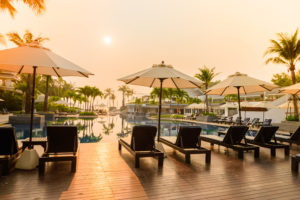 When designing a senior living community, there are numerous architectural considerations at the forefront of the process. And one of the most important factors extends well beyond the community’s buildings themselves.
When designing a senior living community, there are numerous architectural considerations at the forefront of the process. And one of the most important factors extends well beyond the community’s buildings themselves.
As American architect Louis Kahn once put it, “Architecture is the thoughtful making of space.” This definitely applies to senior living campus design.
Indeed, designing campus spaces, indoors and outdoors, is the foundation of a community’s experience: What visitors can appreciate when they arrive; where residents interact with friends and pursue active interests collectively. Such aspects of thoughtful design add flavor and personality to a community, making it distinct with intrinsic value.
And so, offering the ideal senior living campus means striking a balance between aesthetic appreciation and practical and purposeful uses—a multifaceted process that architect and LifeStar Living’s Vice President of Development Darren Azdell, AIA, knows a lot about.
“From a general perspective, the architect’s role in campus design is largely environmental,” he explains. “We don’t design experiences, we design environments in which people have experiences.”
The first step in this process is creating a sense of spacial continuity.
“To effectively use space in a campus’s design,” says Azdell, “you need to envision not only how residents move from one point to the another, but also how you can help them do so safely and enjoyably.”
Communities benefit from multiple individual destinations that provide a variety of activities supporting both social and physical wellbeing. The connectivity of these spaces becomes space as well, deserving of the same thoughtfulness in design and purpose.
These spaces not only need to be accessible and provide shelter from the elements, but also provide aesthetic aspects that make the journey as enjoyable as the destination.
“Traditionally, parking lots devour our open spaces in a society dependent on automobiles,” notes Azdell. “The trouble is that parking lots are unattractive, serve only a single pragmatic need, and they cut down on the amount of space that residents have to enjoy outdoor activities.”
Parking structures integrated in the design plan are a more expensive solution to providing convenient car storage and access, but can allow more appreciation of open spaces surrounding the campus. They also provide a great way to elevate habitable spaces to enhance views.
While these are good solutions, like closets in a house, they keep growing and become expensive storage for the things we’re not using.
As an alternative, Azdell suggests that active senior living communities pursue opportunities to reduce the car’s presence in our lives. This is already possible with mixed-use communities.
Walking and biking to amenities is healthy and can be enjoyable, but may be prohibitive to seniors as they age. Mass transportation is impersonal and undesirable for most seniors living at our communities, so how about creating new programs like we are seeing occur within major metropolitan areas with a high density of automobiles and building structures?
For example, companies like Zipcar are using their technology and carsharing to shrink the number of vehicles needed. Research indicates their carsharing program reduces over ten cars with one carsharing vehicle. Imagine the ability to borrow a luxury electric vehicle, drive when and where you want, and return it without the worries of ownership costs.
Azdell, who is actively using this technology, suggests carsharing can be an included resort service. “We’ve used golf carts this way,” he says, “and these vehicles are essentially driven just like larger more protective golf carts, freeing up space that residents can use all the time!”
Edible gardens, pools, lagoons, sports fields and other amenities can now be increased and located more conveniently in the space left available.
Then there’s the matter of climate.
Air quality and flow are critical functions of campus design in any environment.
In this case, the architect must make sure that pathways are sufficiently protected from, but still lit by, the sun, picking the right plants, trees, and ground surfaces to allow for pleasant, temperate environments.
Ventilation, too, is crucial to resident comfort.
The orientation of campus buildings, for one, helps to manipulate prevailing winds, as does the introduction of open spaces like grassy fields, meadows, and lagoons—all of which serve to accelerate air movement.
Utilizing this combined design strategy, the architect converts portions of the campus into makeshift wind tunnels—a phenomenon known as the “Venturi Effect.”
“Airflow is a driving factor in the architectural approach to LifeStar’s ongoing redesign of The Colonnade of Estero,” explains Azdell. “The original layout had produced stifling environments with very little breeze. By reconfiguring the community’s apartment buildings, we’re opening up space enough for the campus to breathe, giving residents beautiful outdoor conditions.”
But beauty, comfort, and accessibility aside, space is also a core principle in the creation and preservation of a healthy living environment—particularly in a post-pandemic era.
“We have to be nimble with campus space,” says Azdell. “The pandemic has put us in a position where we need to be flexible in our strategic approach to design.”
For example, once considered luxuries, outdoor dining arrangements have become something of an expectation following COVID, especially in senior living. According to Azdell, the lion’s share of senior living communities with outdoor dining were in warm states like Florida prior to the pandemic.
Not anymore.
People all over the world have changed the way they think about space, and outdoor dining is a big part of that transition. Our definition of “close quarters” has shifted both inside and out; designers must allocate space in a way that that meets the needs of individuals with a variety of different health concerns.
Ultimately, the architect’s task of designing space to enhance the daily life experiences of a community’s residents involve a variety of skills and considerations. A reason why LifeStar serves as an end-to-end solution of designers, marketers, and operators to deliver its clients with evidence-based experiences and outcomes. From the aesthetic to the practical, even the scientific, a campus’s environment is the result of a synergistic effect that blends pleasure and convenience with the demands of necessity.

